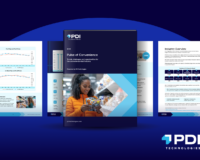
The fuel industry is anything but predictable. Yes, it’s often complex and volatile, but you can’t say it’s ever boring. One reason it’s so unpredictable and complicated is the large number of interwoven parts of the fuel supply chain—from refiners to retailers.
Part of that complexity stems from a lack of integrated platforms as well as companies that are on vastly different stages in their digital transformation. For instance, the COVID pandemic quickly revealed the fragility of these supply chain connections and dependencies.
In spring 2020, gasoline demand was down nearly 50% compared to the previous year—the lowest consumption in decades. Meanwhile, convenience retailers were enjoying record-high fuel margins. In the first quarter of 2020, margins averaged 10 cents per gallon higher than the full year of 2019. Unfortunately, petroleum wholesalers weren’t as fortunate as people stayed home and demand quickly plummeted. At that point fuel prices got simultaneously hit by both the lingering impacts of the pandemic and an oil price war.
When you can’t easily predict what’s coming next in a fluctuating market, the best strategy is to make your business as adaptable as possible. Here are three good ways to control what you can in terms of optimizing your fuel supply operations:
- Control your inventory
- Streamline your bill-of-lading (BOL) process
- Automate credit management
Control Your Inventory
Maintaining inventory is probably one of the most significant contributors to daily operating expenses for petroleum marketers. So, try to control your inventory to avoid costly retains and runouts. A sophisticated inventory management solution can deliver accurate insight into your inventory levels, down to the smallest detail—whether you’re managing a bulk plant or operating a warehouse with lubricants and other petroleum-based packaged goods.
Either way, it’s smart to refine your process of balancing between over- and under-stocking, especially during periods of fluctuating demand. And while predicting demand isn’t an exact science, basing your inventory decisions on historical data or unique factors in your area can help produce accurate forecasts to prevent inventory excesses or shortages.
Streamline Your BOL Process
Many businesses discover that automating the fuel supply chain tends to be a complex undertaking. In fact, the process of providing an accurate BOL and invoice used to take days or weeks, especially for fuel suppliers that relied on paper-based mail delivery. Even in the age of automation, some suppliers are still delivering bills of lading and processing invoices. And that’s where the complexity and challenges lie. Here’s why.
The BOL is one of the most critical documents in a fuel supplier’s workstream. It contains vital information about what, how much, and to whom the product was delivered. It’s the foundation for the invoice that follows. If any crucial details are incorrect as a result of manual processes, that not only delays your time-to-cash but opens up the possibility of creating such a horrible service experience that your customers start considering other suppliers.
The way you avoid that is to go digital and automate as much of your process as possible, making it easier for your customers to integrate with their own systems.
Automate Credit Management
Proper credit management and collection is critical for all fuel suppliers. However, it’s even more important during periods of declining sales and low-profit margins. At that point, fractions of pennies matter. It’s not unusual for large suppliers with multiple business lines and thousands of customer accounts to see multi-million-dollar fluctuations from week to week. A good management solution provides the essential tools to monitor your accounts and automate the credit management process.
For example, if a customer exceeds their credit limit, it typically means they’re not consistently paying their invoices on time. In this case, the automated system should enact a hold on their credit that prevents them from placing an order until the matter is resolved. Many of today’s solutions can support this, and they can also send rules-triggered customer communications before a bill is due or when an account is overdue by a certain number of days.
Go Digital to Mitigate Market Fluctuations
If you’re human, you can’t help but feel uncomfortable during periods of lower sales and tighter margins. But you now have good options for controlling what you can. The more efficient you can make your operations, the more prepared you’ll be to remain profitable despite fluctuating market conditions.
Stay prepared for the next big event with PDI logistics management solutions.


